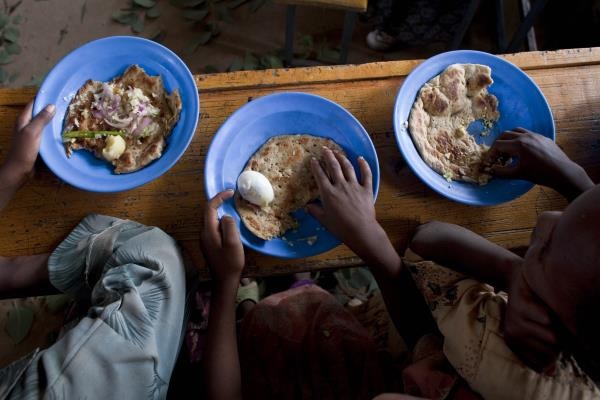
9 March 2017, Rome – International School Meals Day, celebrated around the world today, is a timely reminder of the need to promote healthy eating habits for all children through sustainable policies, including sourcing food from family farmers.
Every day around 370 million children around the world are fed at school through school meals programmes that are run in varying degrees by national governments.
Each programme is different: beans and rice in Madagascar, spicy lentils in the Philippines, vegetable pastries and fruit in Jordan. In some countries it may be a healthy snack, or it could include take-home food such as vitamin A-enriched oil for the whole family.
School meals have proved successful in providing educational and health benefits to the most vulnerable children. School meals boost school attendance, and a full stomach can help students concentrate on their lessons.
Communities, particularly in rural areas, also benefit when family farmers and small and medium enterprises are the main source of healthy food for the schools.
International School Meals Day marks these achievements and helps raise greater awareness of the value of school meals globally.
A generation of well-nourished children
FAO believes that consistent global investments in school meals will lead to a generation of children who develop healthy eating habits and who benefit from a diverse diet. Ultimately this effort will contribute to achieving the Sustainable Development Goal of Zero Hunger.
FAO supports school meals in a range of ways including technical support to governments on sustainable agriculture, food safety and standards, support to family farmers to grow surplus harvests to sell to schools, public procurement regulations, nutritional and food guidelines and nutrition education activities.
On the policy front, FAO is working with governments and other partners to bring together a range of sectors - such as health, education, social protection and agriculture - to formulate comprehensive and effective national policies that can be implemented in a government-led setting.
This month, FAO jointly presented the Home-Grown School Feeding Resource Framework, together with partners including the World Food Programme. The framework supports governments through the process of policy formulation, implementation and evaluation of school meals programmes. It also brings together the technical expertise of different stakeholders in a programmatic and coherent way to be easily accessed by countries requesting technical assistance.
Family farmers a link in the school meals supply chain
In Africa, the Purchase from Africans for Africa (PAA Africa) programme is modelled on Brazil's achievements in fighting hunger and poverty, and is helping promote local agricultural production and school meals.
FAO provides technical assistance for governments to procure food for public institutions, such as schools, directly from small-scale family farmers. FAO teams also work directly with family farmers to help them achieve sustainable gains in agricultural productivity, as well as improve their harvesting and post-harvest techniques leading to better quality produce and less loss and waste.
During the programme's second phase, around 16,000 family farmers were able to sell 2,700 tons of food for school meals for around 37,000 students.
Helping children make healthy choices
The school is an ideal setting for teaching basic skills in food, nutrition and health. In many communities, schools may be the only place where children acquire these important life skills.
Among many tools, growing and preparing garden food at school can be instrumental. Combined with diversified school meals and nutrition education, it increases children's preferences for fruits and vegetables. This food and nutrition education is an essential element in the prevention and control of diet-related health problems. For this reason, FAO provides technical assistance for integrating food and nutrition education in the primary school curriculum.
FAO also supports schools to ensure that all foods, meals and snacks available at school are nutritionally adequate and appropriate for the school-age child.
Case study: Latin America and the Caribbean
In 2009, a school feeding programme based on the National School Feeding Programme of Brazil was launched in Latin America and the Caribbean. Through inter-sectoral policy and legal mechanisms it developed actions for food and nutrition education, and encouraged purchases for the programmes to be made from local farming families. In 2013, a study conducted in eight of the participating countries, surveying a territory encompassing 18 million students, showed that the programmes not only promote school attendance and bolster the learning process, but also increase the income of the community's farmers.
Case Study: Cape Verde
In Cape Verde, the school meals programme was introduced by the UN in 1979, and the government took ownership in 2010. Since then FAO has worked with the government and other UN agencies to diversify the school meals by linking local farmers to the procurement process to increase the supply of local fruit, vegetables, beans and fish to school canteens. Around 9000 primary school students benefited from this initiative, as did local farmers and fishers who had an assured market.